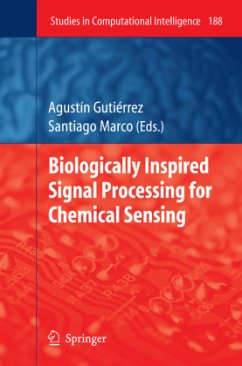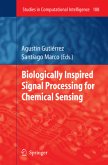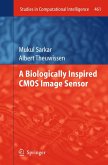This volume presents a collection of research advances in biologically inspired signal processing for chemical sensing. The olfactory system, and the gustatory system to a minor extent, has been taken in the last decades as a source of inspiration to develop artificial sensing systems. The performance of this biological system outperforms in many aspects that of their artificial counterpart. Thus, the goal of researchers in this field is to understand and capture those features that make the olfactory system especially suited for the processing of chemical information. The recognition of odors by the olfactory system entails a number of signal processing functions such as preprocessing, dimensionality reduction, contrast enhancement, and classification. Using mathematical models to mimic the architecture of the olfactory system, these processing functions can be applied to chemical sensor signals. This book provides some background on the olfactory system including a review on information processing in the insect olfactory system along with a proposed signal processing architecture based on the mammalian cortex. It also provides some bio-inspired approaches to process chemical sensor signals such as an olfactory mucosa to improve odor separation and a model of olfactory receptor neuron convergence to correlate sensor responses to an odor and his organoleptic properties.
Biologically inspired approaches for artificial sensing have been extensively applied to different sensory modalities over the last decades and chemical senses have been no exception. The olfactory system, and the gustatory system to a minor extent, has been regarded as a model for the development of new artificial chemical sensing s- tems. One of the main contributions to this field was done by Persaud and Dodd in 1982 when they proposed a system based on an array of broad-selective chemical sensors coupled with a pattern recognition engine. The array aimed at mimicking the sensing strategy followed by the olfactory system where a population of bro- selective olfactory receptor neurons encodes for chemical information as patterns of activity across the neuron population. The pattern recognition engine proposed was not based on bio-inspired but on statistical methods. This influential work gave rise to a new line of research where this paradigm has been used to build chemical sensing instruments applied to a wide range of odor detection problems. More recently, some researchers have proposed to extend the biological inspiration of this system also to the processing of the sensor array signals. This has been mo- vated in part by the increasing body of knowledge available on biological olfaction, which has become in the last decade a focus of attention of the experimental neu- science community.
Biologically inspired approaches for artificial sensing have been extensively applied to different sensory modalities over the last decades and chemical senses have been no exception. The olfactory system, and the gustatory system to a minor extent, has been regarded as a model for the development of new artificial chemical sensing s- tems. One of the main contributions to this field was done by Persaud and Dodd in 1982 when they proposed a system based on an array of broad-selective chemical sensors coupled with a pattern recognition engine. The array aimed at mimicking the sensing strategy followed by the olfactory system where a population of bro- selective olfactory receptor neurons encodes for chemical information as patterns of activity across the neuron population. The pattern recognition engine proposed was not based on bio-inspired but on statistical methods. This influential work gave rise to a new line of research where this paradigm has been used to build chemical sensing instruments applied to a wide range of odor detection problems. More recently, some researchers have proposed to extend the biological inspiration of this system also to the processing of the sensor array signals. This has been mo- vated in part by the increasing body of knowledge available on biological olfaction, which has become in the last decade a focus of attention of the experimental neu- science community.








